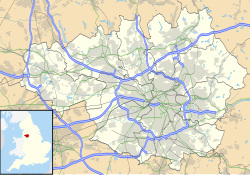History
The cenotaph was commissioned after the First World War to honour local servicemen who died in the conflict. It was designed by Sydney March of March Bros., Farnborough, Kent, with the site layout by A. Baines Barker of London. [1] The stonework was executed by F. M. & H. Nuttall Ltd of Whitefield. [2] The memorial was unveiled on 26 November 1922 at a cost of approximately £5,000. [3] Additional plaques for the Second World War were added later, and a rededication ceremony took place on 30 April 1949. [4]
On 10 March 1992, Radcliffe Cenotaph was designated a Grade II* listed building for its architectural and historic significance. [2]
Private James Hutchinson VC
As part of a national initiative to honour First World War Victoria Cross recipients, [5] a commemorative stone dedicated to Private James Hutchinson VC (1895–1972) was installed at the cenotaph in 2016. Hutchinson, a Radcliffe native who served with the 2/5th Battalion, The Lancashire Fusiliers (55th (West Lancashire) Division), was awarded the Victoria Cross for exceptional bravery during a trench raid near Ficheux, France, on 28 June 1916. The stone was unveiled during a public ceremony attended by his family, local residents, and civic representatives, featuring a parade and formal tributes. [6]
Design
The memorial takes the form of an obelisk made from Darley Dale sandstone, rising to approximately 10.7 metres (35 ft) above street level. It is set on a square raised terrace approached by four broad steps and surrounded by ashlar walls. The base consists of seven steps leading to a cruciform pedestal. [1]
Plaques
Four large bronze panels on the main faces list 642 names of those who died during the First World War. Narrow re-entrant sides carry rectangular panels commemorating those who died in the Second World War. A bronze cartouche on the rear bears the inscription: "TO OUR GLORIOUS DEAD 1914–1918" along with the Radcliffe coat of arms. [2]
Sculptural elements
Three large bronze statues represent Victory, Liberty, and Peace. Victory stands centrally, holding a laurel wreath aloft and clasping Liberty's hand. Liberty raises a flaming torch, while Peace reclines with roses of remembrance and a dove resting on her shoulder. [1]
This page is based on this
Wikipedia article Text is available under the
CC BY-SA 4.0 license; additional terms may apply.
Images, videos and audio are available under their respective licenses.







